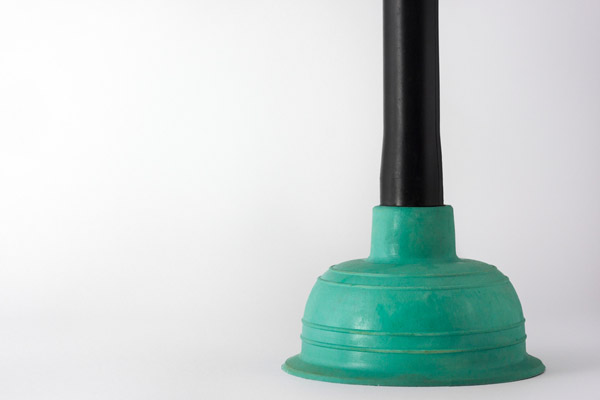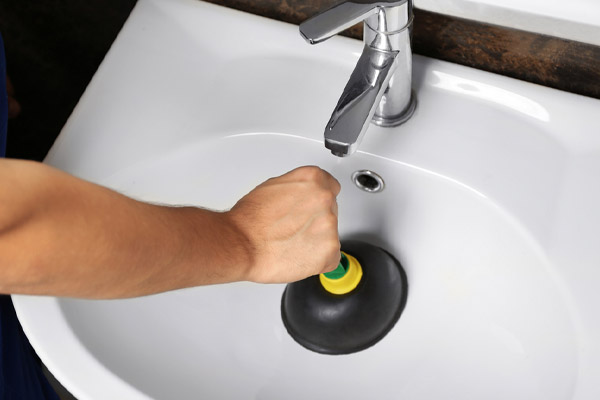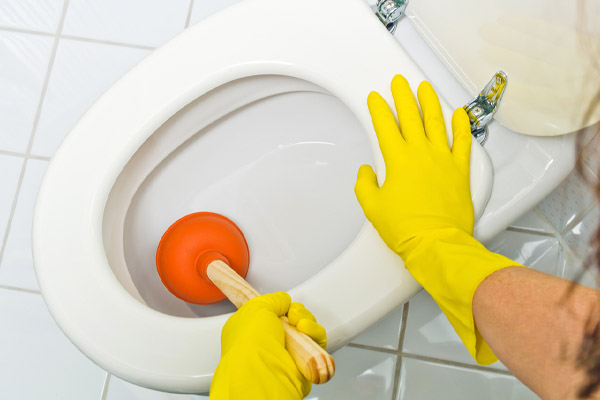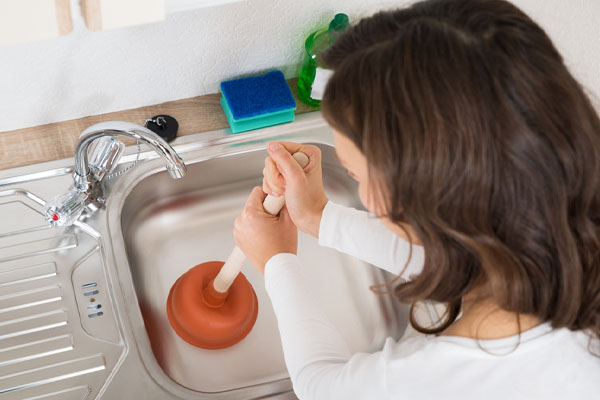Plumbing woes can strike any household, often demanding immediate attention. A clogged drain, such as a sink, a slow-draining bathtub, or a stubborn toilet are common scenarios where a handy plunger can be a savior. At Robinson Plumbing, we understand the urgency and frustration that comes with these situations. Our commitment extends beyond professional services; we aim to empower our customers with practical solutions for everyday plumbing challenges. This article serves as a guide to help you understand the different types of plungers. This way, you can select and use the right plunger, ensuring a swift and effective resolution to your plumbing issues.
Understanding the Basics of a Plunger
Contents [hide]
- 1 Understanding the Basics of a Plunger
- 2 Call Robinson Plumbing For Superior Plumbing Services
A plunger, essential for plumbing, clears pipe and drain blockages through suction and pressure. Evolving from basic designs to more efficient models, it’s effective for minor clogs, saving time and professional service costs. Robinson Plumbing emphasizes its necessity in every household for addressing immediate plumbing problems and routine maintenance. However, it’s important to understand the different types of plungers.
Understanding the different types of plungers is essential for tackling various plumbing issues effectively. Each type is uniquely designed for specific tasks.
Cup Plunger
The Cup Plunger, often seen in most homes, features a simple rubber cup attached to a handle. It’s best suited for flat surfaces, making it ideal for unclogging sinks, bathtubs, and showers. The cup creates a seal over the drain, allowing for effective suction and pressure application.
Flange Plunger
The Flange Plunger, one of the most common types of plungers, is specifically designed for toilets. It includes an extended rubber flange beneath the cup, which fits perfectly into the toilet drain. This unique design enhances the suction power, making it more efficient for toilet clogs compared to the standard cup plunger.
Accordion Plunger
For tougher clogs, especially in toilets, the Accordion Plunger is a more robust option. Made of hard plastic, it has an accordion-style body. This design allows it to exert more force, although it can be more challenging to use due to its rigid material.
Taze Plunger
The Taze Plunger is specialized for large, industrial plumbing systems. It’s used to clear significant blockages in main sewer lines and is typically operated by professionals due to the complexity of the tasks it handles.
For more detailed advice and solutions, feel free to contact Robinson Plumbing. We’re here to assist with all your plumbing needs, big or small.
How to Select the Right Plunger
Selecting the right plunger is essential for effectively addressing different plumbing issues. Here are key factors to consider:
Drain Type
- Flat Surfaces (Sinks, Showers, Bathtubs): Use a Cup Plunger.
- Toilets: Choose a Flange Plunger for its extended rubber flange, ideal for toilet drains.
Plunger Features
- Cup Size and Shape: Match the plunger cup to the drain size.
- Handle: Opt for a handle with sufficient length for leverage and made of durable material like wood or strong plastic.
- Rubber Quality: Select a plunger with a balance of firmness and flexibility to create an effective seal.
Selection Tips
- For simple clogs, a Cup Plunger usually suffices. Tougher clogs, especially in toilets, may require an Accordion or Flange Plunger.
- Ensure the plunger cup can fully cover the drain opening for a tight seal.
Keep a variety at home for various needs, and for complex issues, don’t hesitate to contact Robinson Plumbing for professional assistance.
Proper Usage and Techniques of Types of Plungers
To effectively use a plunger, choose the right type for the clog. For sinks and tubs, use a Cup Plunger with a full seal and vigorous motions. In toilets, a Flange Plunger works best with strong, consistent plunges, ensuring proper insertion and water coverage. The Accordion Plunger may need more force.
It’s important to avoid common errors such as poor sealing or choosing the wrong plunger. Safety is key: steer clear of chemicals, manage water levels, maintain steady motions, and ensure ventilation. Following these techniques and safety measures increases the likelihood of successfully clearing clogs.
Maintenance and Storage of Types Of Plungers
Maintaining and storing plungers correctly is crucial for hygiene and functionality. Clean and disinfect the plunger after use with a bleach solution, and dry it well to avoid mold. Store it upright in a utility closet or bathroom, using a holder or hook to preserve its shape and a tray to prevent contact with floors or walls. This keeps the plunger in good condition and your space clean.
Advanced Plunging Tips and Tricks
For tough clogs, combining traditional plunging with advanced methods can be more effective. Soften clogs in sinks or tubs with hot water before plunging. Use vinegar and baking soda, especially for kitchen sinks, to break down grease. Seal unused drains or overflow holes to improve plunging efficiency. If gentle plunges don’t work, try more forceful actions or switch to a flange or accordion plunger for more power. Often, persistence and multiple attempts are necessary to completely clear a clog.
When to Call a Professional Plumber
When persistent or severe plumbing issues arise, such as repeated or multiple clogs, water backflow, or the failure of DIY methods, it’s advisable to seek professional help. Unusual noises or odors from drains can also indicate deeper problems within your plumbing system. In these instances, Robinson Plumbing offers expert assistance with a team capable of diagnosing and resolving complex challenges. Their services not only provide an immediate fix but also contribute to the long-term health and efficiency of your home’s plumbing, preventing future issues and potential damage.
FAQs About Types Of Plungers
- Can I use the same plunger for both my sink and toilet? – Understanding the differences in types of plungers is crucial. While you might be tempted to use one plunger for all purposes, it’s not always effective or hygienic. This question addresses why different plungers are designed for specific tasks and the importance of using the correct type for each plumbing issue.
- What should I do if a plunger doesn’t clear a clog? – Not all clogs can be solved with a plunger, and it’s important to know the next steps. This question explores alternative methods for dealing with stubborn clogs and when it’s time to call a professional plumber.
- How often should I clean and replace my plunger? – Proper maintenance of a plunger is key to its effectiveness and hygiene. This question provides guidelines on the cleaning and upkeep of plungers and signs that indicate it’s time to replace them.
Conclusion
In summary, selecting and using the right plunger is essential for effective plumbing maintenance. Different types of plungers, like the cup plunger for sinks and bathtubs and the flange plunger for toilets, are designed for specific tasks. Proper technique is crucial, from gentle push-pull actions for minor blockages to more vigorous efforts for stubborn clogs. Regular maintenance and correct storage of plungers ensure their readiness and effectiveness. While plungers handle many issues, recognizing when professional help is needed, such as from Robinson Plumbing, is vital for preventing serious problems and maintaining the long-term health of your plumbing system.
Call Robinson Plumbing For Superior Plumbing Services
Contact Robinson Plumbing, a trusted Lehigh Valley company, for a range of reliable services like drain clogs, water heater replacements, toilet repairs, and more. We provide multiple solutions to suit your home and budget for any repair or replacement needs.
Facing an unexpected plumbing issue? Robinson Plumbing’s expert team offers same-day emergency services, ensuring quick, correct, and affordable solutions.
Robinson Plumbing, known for being the most affordable plumbing company in the Lehigh Valley, ensures customer satisfaction with licensed plumbers and guaranteed work. Schedule your free estimate with us today.
Call us today at (610) 351-9889 or contact us for any questions that you might have! Click the link to view our service area.
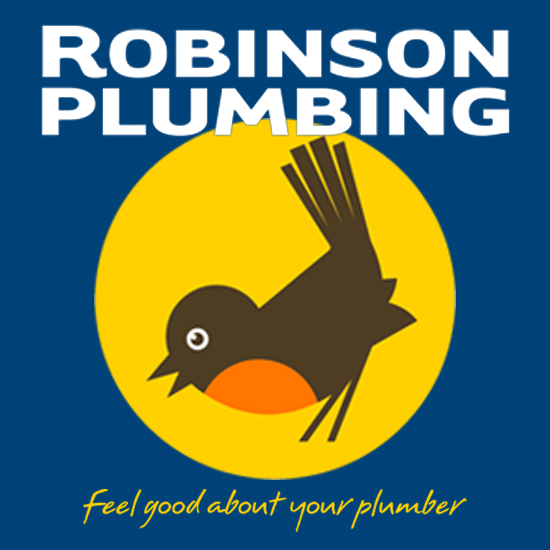
Related Articles:

